3D Bioprinting Market Size
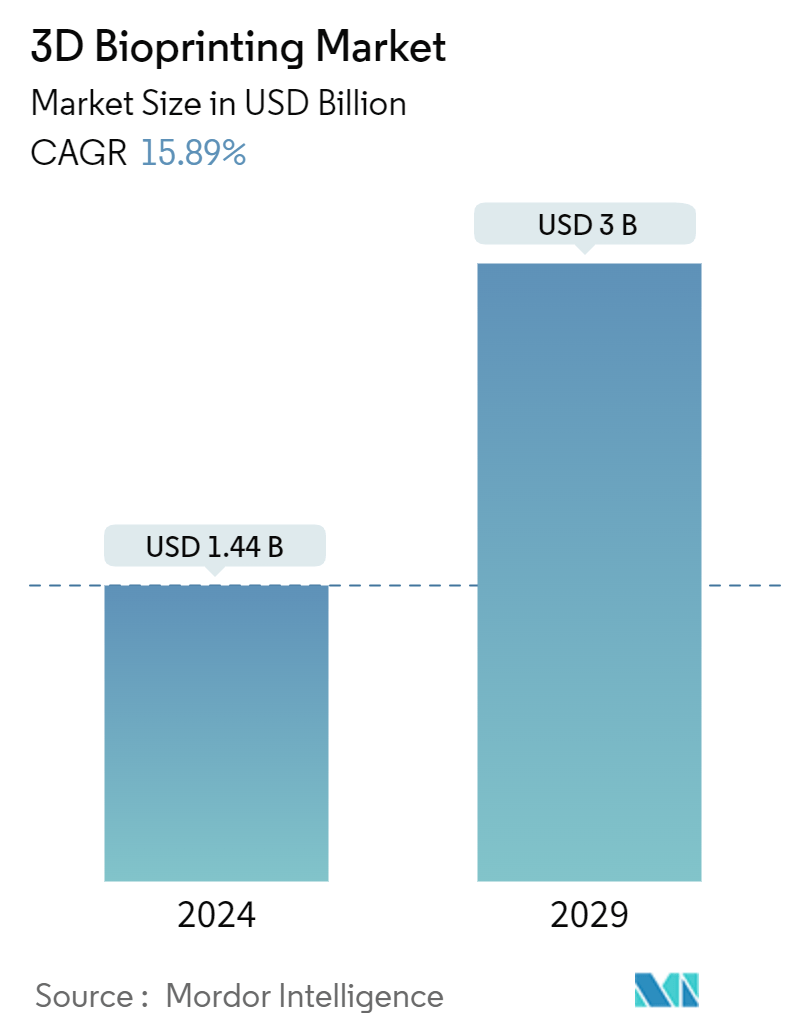
| Study Period | 2019 - 2029 |
| Market Size (2024) | USD 1.44 Billion |
| Market Size (2029) | USD 3 Billion |
| CAGR (2024 - 2029) | 15.89 % |
| Fastest Growing Market | Asia Pacific |
| Largest Market | North America |
Major Players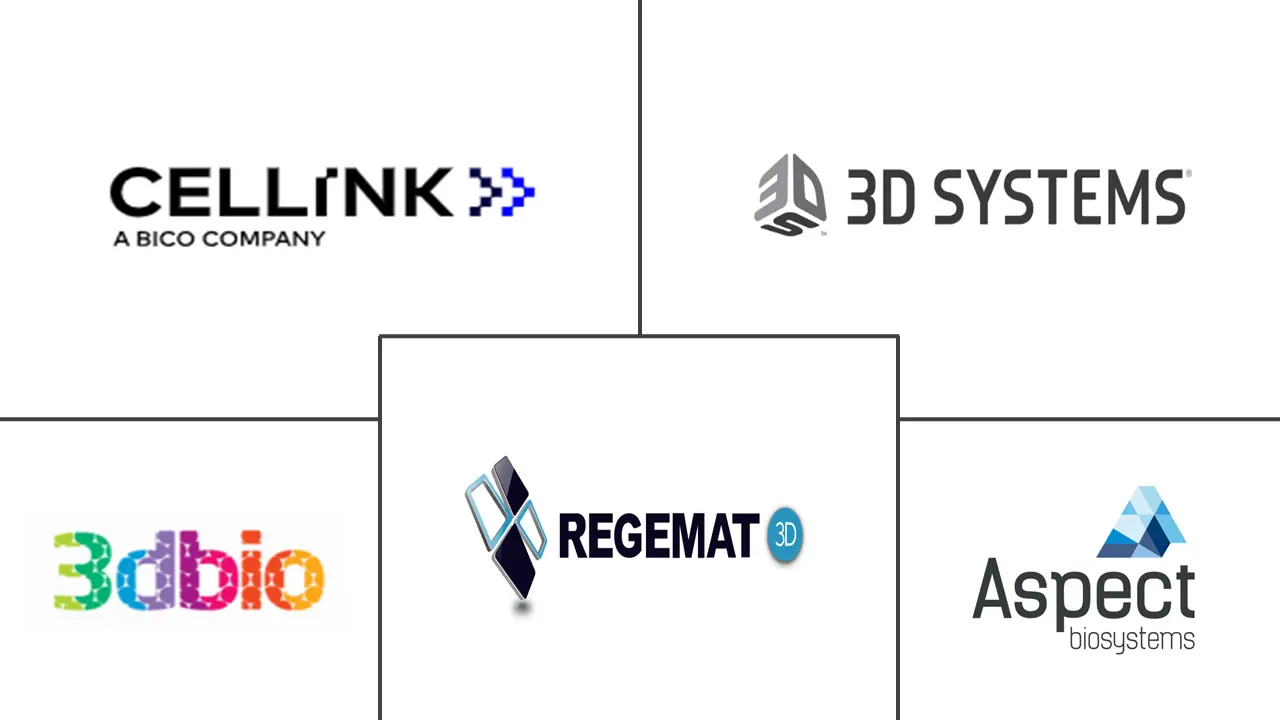
*Disclaimer: Major Players sorted in no particular order |
3D Bioprinting Market Analysis
The 3D Bioprinting Market size is estimated at USD 1.44 billion in 2024, and is expected to reach USD 3 billion by 2029, growing at a CAGR of 15.89% during the forecast period (2024-2029).
- 3D bioprinting involves using bio-inks to print living cells in a layer-by-layer process, replicating the behavior and structures of natural tissues. Bioinks, utilized as a substance in bioprinting, consist of organic or artificial biomaterials that can be blended with viable cells. This innovative technology is utilized in fields like tissue engineering and pharmaceutical research, with the healthcare sector poised to embrace it rapidly.
- The utilization of technology and bioprinted structures allows researchers to examine the functionalities of the human body in vitro. In comparison to 2D in vitro studies, 3D bioprinted structures offer a higher level of biological relevance. The market growth is expected to be positively influenced by factors such as increased investment in research and development, advancements in technology, and the rising prevalence of chronic diseases. Additionally, this technology facilitates the design of personalized medical devices and implants tailored to meet the unique requirements of individual patients.
- 3D bioprinting has various applications in tissue engineering, bioengineering, and materials science. Additionally, it is being utilized more frequently in pharmaceutical development and drug validation. Bioprinting research focuses on clinical applications like 3D printed skin, bone grafts, implants, and even fully printed organs. These products are utilized in various clinical and research settings. While these modified medical products can replicate natural tissues and organs, they are not suitable as replacements for the original organs.
- According to WHO, 3D bioprinting has the potential to address important public health issues, like the need for human organ and tissue repair or replacement. The anticipated uses of this technology encompass research, training, and a variety of medical applications. The increase in research and development efforts, the rise in awareness of 3D bioprinting, the expanding elderly population, the adoption of advanced technologies, and the growth in healthcare spending all contribute positively to the 3D bioprinting market.
- Numerous enterprises are investing heavily in research and development to enhance technology by making significant advancements and introducing innovative products. One such example is Organovo, a medical laboratory and research firm leading the way in the United States in the field of 3D bioprinting. The company gained recognition by providing pharmaceutical companies with its exVive3D Liver Tissue for testing medicine toxicity. It has partnered with notable companies like Merck and L'Oréal in the healthcare sector and is now gearing up to launch its exVive3D Kidney Tissue product.
- Three-dimensional bioprinting technology holds promise in addressing various challenges in healthcare. For instance, functional bladders created from bioprinted tissue derived from patients' cells have already been effectively transplanted into humans. Scientists are continuously exploring the potential of bioprinting additional functional organs. Additionally, a potential future outcome of 3D bioprinting is the elimination of the need for organ donors, as personalized human organs can be produced using the patient's own cells or stem cells as a foundation.
- The COVID-19 pandemic prompted the 3D printing community to step up and offer their assistance in manufacturing essential medical equipment for hospitals that were facing challenges. Conversely, the expensive nature of 3D bioprinting and the absence of regulatory frameworks overseeing this technology are anticipated to impede the growth of the 3D bioprinting market. Moreover, the increasing socioethical issues surrounding the utilization of 3D bioprinted items are likely to pose a challenge to the market during the forecast period.
- The COVID-19 pandemic significantly expedited technological advancements in pharmaceuticals, medical devices, and manufacturing technologies due to disrupted supply chains and increased demand for treatments and materials. One of these advancements was 3D bioprinting, which involves arranging encapsulated cells or other biological materials (bio-inks) using a 3D printer to build tissue, organs, or biocompatible scaffolds that can enhance tissue growth.
3D Bioprinting Market Trends
Drug Testing and Development Are Expected to Hold a Significant Market Share
- The field of drug testing and development greatly benefits from the implementation of 3D bioprinting technologies as they offer more precise and effective methods for pharmaceutical testing. Conventional drug testing models, such as animal testing and 2D cell cultures, have limitations in accurately predicting human reactions to new medications. On the other hand, 3D bioprinted tissues offer more realistic models that closely mimic actual organ systems and disease conditions, leading to faster and more dependable drug screening and development procedures.
- The remarkable advancement of 3D printing has paved the way for pharmaceutical applications, allowing for the creation of personalized drug screening and drug delivery systems tailored to each patient. This marks a departure from traditional methods that heavily depended on transgenic animal experiments and large-scale production. 3D printing enhances the effectiveness of current drug screening platforms by precisely placing biomaterials with patient-specific cells, thus replicating the natural conditions of the afflicted human body.
- The drug development process is an extensive, expensive, and demanding endeavor, but it is essential for introducing a new medication to the market. Typically, numerous compounds undergo multiple screening stages prior to clinical trials in the pursuit of drug discovery, and ultimately, only one compound receives approval. Traditionally, drug screening has heavily relied on transgenic animals as disease models. However, with the emergence of 3D bioprinting, new techniques are being developed to enhance the effectiveness of drug development.
- The market growth is expected to be supported by strict regulations imposed by government agencies, which require drug testing for safety reasons. Additionally, there is an increasing focus on monitoring and combating substance abuse, which further contributes to the market’s growth. The rising prevalence of substance abuse worldwide has led to higher demand for drug testing. The significant advancements in 3D printing technology have paved the way for pharmaceutical applications, allowing the creation of personalized drug screening and drug delivery systems for individual patients.
- For instance, in December 2023, FluidForm Bio, a US biotechnology company, made progress in 3D-printing human cardiac tissue using freeform reversible embedding of suspended hydrogels (FRESH) 3D bioprinting technology. By utilizing human induced pluripotent stem cell-derived cardiomyocytes (hiPSC-CMs), FluidForm managed to create an accurate model of human cardiac physiology for drug development purposes. This collaborative study involved scientists from FluidForm and Merck (MSD). Such significant developments in the field of 3D bioprinting for drug development applications will drive the market's growth.
- Pharmaceutical companies are using bioprinted tissues for drug testing, enabling them to swiftly identify promising candidates and eliminate ineffective or hazardous ones at an early stage of development. This enhanced efficiency can lead to substantial cost savings in research and development, as well as expedite the availability of innovative therapies. The rising prevalence of chronic diseases and the increasing demand for safe medications within the medical sector will further fuel the market's growth. Additionally, the emergence of 3D bioprinting allows drug developers to address the challenges associated with human clinical trials by promptly identifying potential complications. These advantages are expected to further bolster the market's expansion in drug development applications.
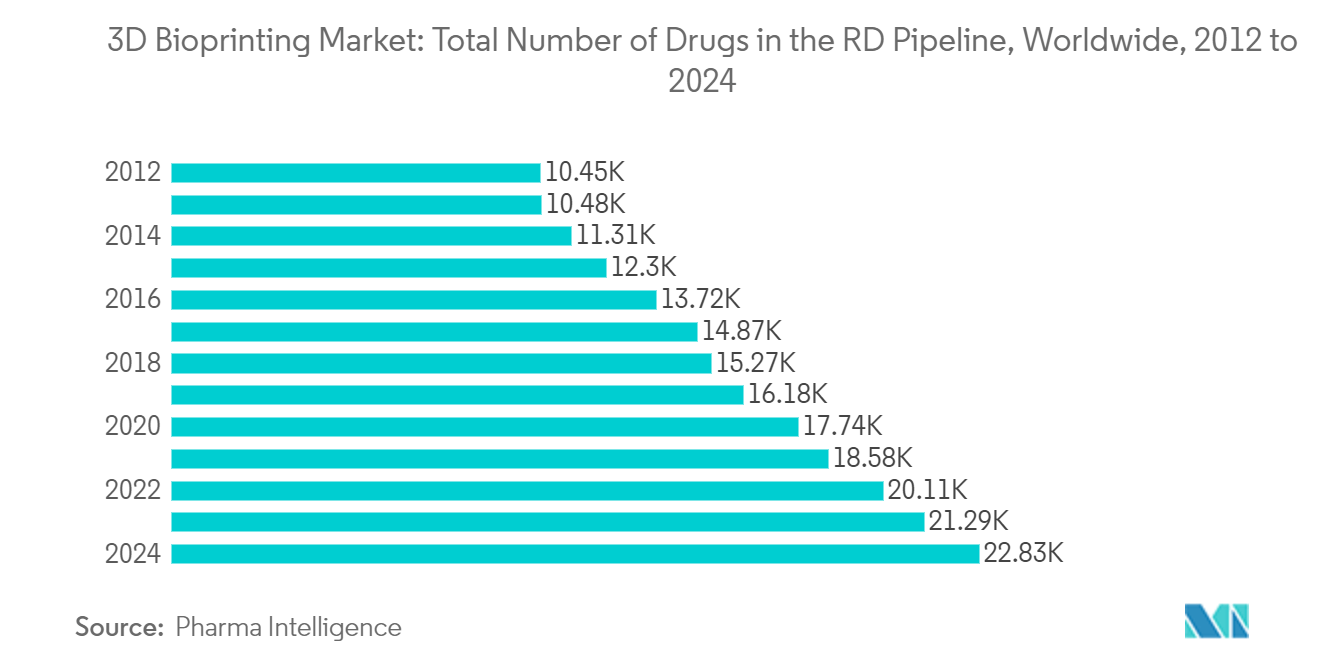
Asia-Pacific is Expected to Witness Significant Growth
- Asia-Pacific is the fastest-growing market for 3D bioprinting, mainly due to a strong existing consumer base, the massive scope of 3D printing in medical services, increasing R&D for 3D printing, and government support and tax incentives. The adoption of 3D printing in China is rapidly picking pace compared to other developed economies, such as North America and Europe, though it was not among the earliest adopters of the technology. The primary factor driving this growth is the support from the Chinese government in the innovation, development, and adoption of the technology across several end-user industries in the country.
- The country also witnessed various kinds of research in bio-manufacturing. Tsinghua University (Beijing, China) is one of the leading laboratories in the interdisciplinary field of additive manufacturing and 3D bioprinting. Sponsored by the Ministry of Science and Technology of China, the National Natural Science Foundation of China, the National Health Commission of China, and the Beijing Municipal Science & Technology Commission, its bio-manufacturing center is highly dedicated to conducting research involving biomaterials, living cells, proteins, and other biological compounds, as basic building blocks to fabricate biomimetic structures. This research finds applications in various areas, such as tissue engineering, regenerative medicine, disease pathogenesis, drug screening, and tissue/organ-on-a-chip.
- Chinese scientists have made significant progress in the field of 3D bioprinting, particularly with the liquid-in-liquid printing method. By utilizing liquid polymers, they have developed a technique that forms a durable membrane when the liquids come into contact. These liquid structures have the remarkable ability to maintain their shape for up to 10 days before eventually merging. This innovative approach enables the printing of intricate shapes and opens up possibilities for creating complex 3D-printed tissues using living cells.
- In India, the concept of 3D bioprinting is gradually gaining traction, with a focus on academic and research labs such as the Indian Institute of Science (IISc), Indian Institutes of Technology (IITs), National Institutes of Technology (NITs), Sree Chitra Tirunal Institute for Medical Sciences and Technology (SCTIMST), and other universities. The collaboration between CELLINK, a prominent player in the development of 3D bioprinters, and IISc further propelled the advancement of 3D bioprinting technology. This partnership led to the establishment of a Centre of Excellence (CoE) for 3D bioprinting in Bengaluru, providing a significant boost to the market.
- According to the Indian Brand Equity Foundation, the healthcare sector is one of the fastest-growing in the country. In the recent budget, India's public expenditure on healthcare stood at 1.2% as a percentage of the GDP. The Government of India plans to increase public health spending to 2.5% of the GDP by 2025. Such trends in the healthcare sector are expected to boost the country's market growth significantly.
- Many Indian start-ups are making bioprinting technology popular through innovative solutions. For instance, Biop, established by BITS Pilani and Goa students, aims to change medical research by manufacturing the equipment and technology for 3D bioprinting. The product can form human tissues with one click, using sensors, actuators, and UV technology to control the 3D bioprinting. The company collaborated with MIT and Harvard. The growth of start-ups, as well as the increasing elderly population and cancer cases, is among the significant factors set to fuel the market's growth over the forecast period.
- Pandorum Technologies reported that since India revised its New Drugs and Clinical Trial Rules in March 2023, researchers can employ alternative methods for assessing the safety and efficacy of new medications. This amendment has the potential to greatly enhance the development of 3D bioprinting, a field that has seen significant growth in India in recent years. According to the company, as of January 2024, the 2023 amendment permitted the utilization of 3D bioprinted tissues as a substitute for various laborious preclinical or animal studies. Contract research organizations have already conducted preclinical drug tests on 3D bioprinted corneas.
- The Japanese government estimates that the regenerative medicine industry will record a revenue of JPY 1 trillion by 2030. The New Energy and Industrial Technology Development Organization (NEDO) expects that emerging and innovative technologies, such as 3D bioprinting, may lead the market in the near future.
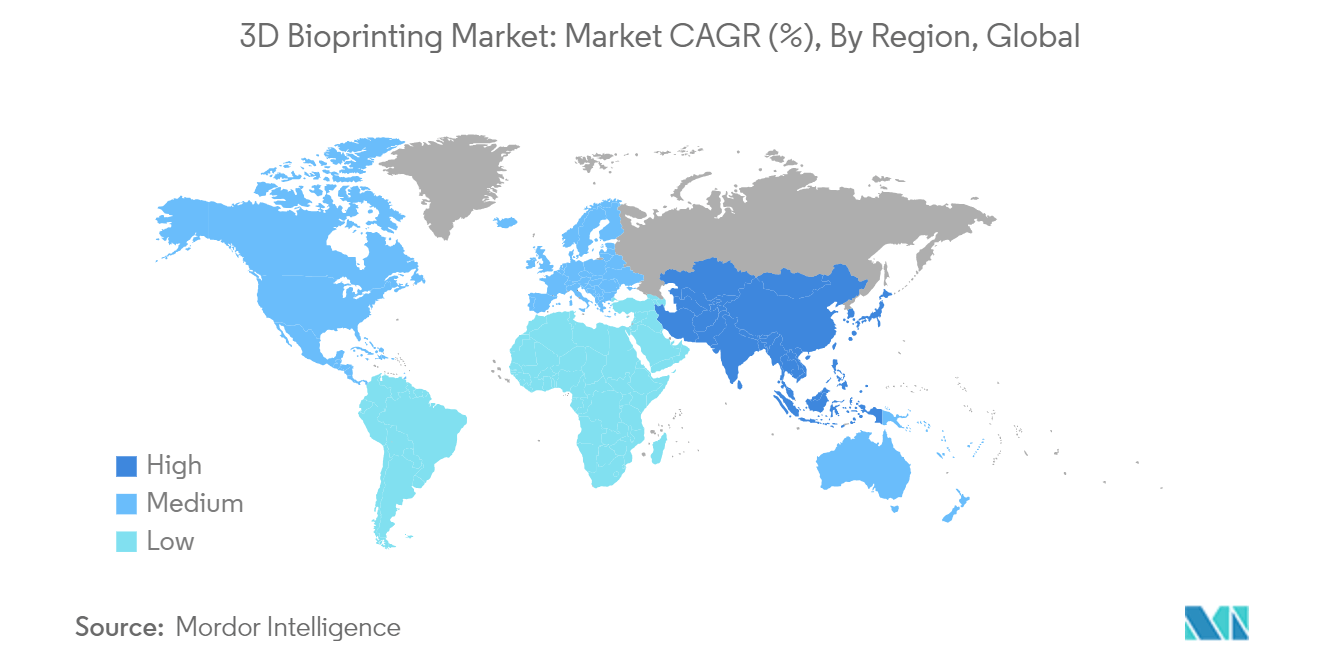
3D Bioprinting Industry Overview
The 3D bioprinting market is very competitive in nature. The market is concentrated due to the presence of various small and large players. Some of the significant players in the market are 3D Systems Corporation, Aspect Biosystems Ltd, GeSIM GmbH, Cellink AB, Cyfuse Biomedical KK, and Envision TEC GmbH.
- May 2024: Nanoscribe and Advanced BioMatrix collaborated to lead the way in the field of bioprinting by introducing four cutting-edge bioresins designed specifically for Two-Photon Polymerization (2PP) based 3D printing. This partnership brings together Nanoscribe's extensive knowledge in highly accurate 3D printing and Advanced BioMatrix's expertise in developing biomaterials, with the goal of greatly improving bioprinting capabilities. These groundbreaking bioresins offer unparalleled precision, resolution, and adaptability, opening up new avenues for exploration and advancement in the life sciences and biomedical sectors and ultimately contributing to the progress of human health.
- September 2023: CELLINK entered into a strategic distribution agreement with Paralab, which signified a notable growth in its operations in Portugal and Spain. This partnership was expected to enable CELLINK to reach a wider audience in Southern Europe by offering advanced bioprinting solutions. By doing so, the company reaffirmed its dedication to advancing regenerative medicine while taking into account the specific characteristics of the region. The collaboration will prioritize the exchange of knowledge, training, and technical support, ensuring that researchers in Portugal and Spain can effectively utilize CELLINK's state-of-the-art bioprinting platforms.
3D Bioprinting Market Leaders
-
Cellink
-
3D Systems Corporation
-
3D Bioprinting Solutions
-
REGEMAT 3D
-
Aspect Biosystems Ltd
*Disclaimer: Major Players sorted in no particular order
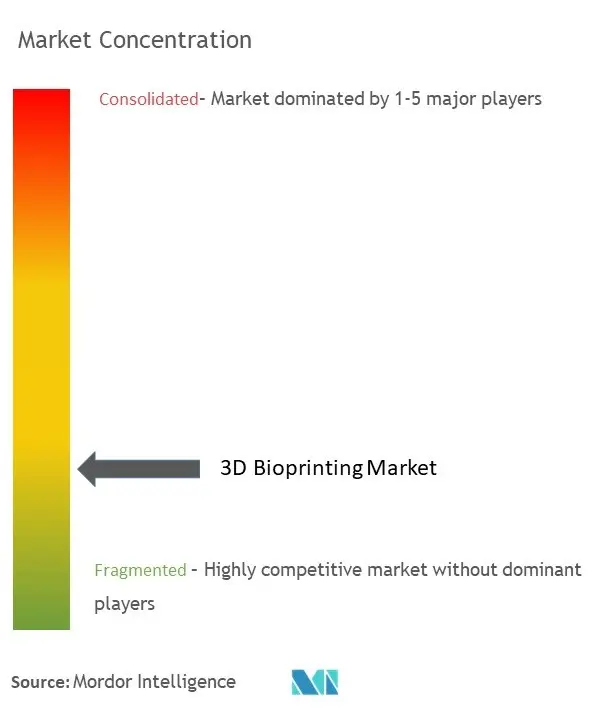
3D Bioprinting Market News
- October 2023: CELLINK and the University of California, San Diego (UCSD) announced their collaboration in setting up a 3D bioprinting Centre of Excellence. The main goal of this partnership is to enhance the use of innovative bioprinting technologies and encourage pioneering research in drug discovery, cancer research, and tissue engineering. The Centre of Excellence will be equipped with top-of-the-line CELLINK bioprinters, such as the BIO X6 and BIONOVA X models, a variety of bioinks, and the latest bioprinting software solutions.
- August 2023: A study was conducted and published in Scientific Reports, wherein scientists successfully created a three-dimensional (3D) model of the breast cancer tumor microenvironment (TME) using bioprinting techniques. This model consisted of cultured cells dispersed in hydrogels, allowing researchers to assess tumor heterogeneity. The study's results demonstrated the effectiveness of combining 3D bioprinting and microfluidic devices in producing tumor structures that accurately represented those found in various individuals.
3D Bioprinting Market Report - Table of Contents
1. INTRODUCTION
- 1.1 Study Assumptions and Market Definition
- 1.2 Scope of the Study
2. RESEARCH METHODOLOGY
3. EXECUTIVE SUMMARY
4. MARKET INSIGHTS
- 4.1 Market Overview
-
4.2 Industry Attractiveness - Porter's Five Forces Analysis
- 4.2.1 Bargaining Power of Suppliers
- 4.2.2 Bargaining Power of Consumers
- 4.2.3 Threat of New Entrants
- 4.2.4 Threat of Substitutes
- 4.2.5 Intensity of Competitive Rivalry
- 4.3 Impact of COVID-19 on the 3D Bioprinting Market
5. MARKET DYNAMICS
-
5.1 Market Drivers
- 5.1.1 Increasing Geriatric Population
- 5.1.2 Increasing Investments in R&D
-
5.2 Market Challenges
- 5.2.1 Operational Challenges
6. MARKET SEGMENTATION
-
6.1 By Technology
- 6.1.1 Syringe/Extrusion Bioprinting
- 6.1.2 Inkjet Bioprinting
- 6.1.3 Magnetic Levitation Bioprinting
- 6.1.4 Laser-assisted Bioprinting
- 6.1.5 Other Technologies
-
6.2 By Component
- 6.2.1 3D Bioprinters
- 6.2.2 Biomaterials
- 6.2.3 Scaffolds
-
6.3 By Application
- 6.3.1 Drug Testing and Development
- 6.3.2 Regenerative Medicine
- 6.3.3 Food Testing
- 6.3.4 Research
- 6.3.5 Other Applications
-
6.4 By Geography
- 6.4.1 North America
- 6.4.1.1 United States
- 6.4.1.2 Canada
- 6.4.2 Europe
- 6.4.2.1 United Kingdom
- 6.4.2.2 Germany
- 6.4.2.3 France
- 6.4.2.4 Rest of Europe
- 6.4.3 Asia-Pacific
- 6.4.3.1 China
- 6.4.3.2 Japan
- 6.4.3.3 India
- 6.4.3.4 Rest of Asia-Pacific
- 6.4.4 Rest of the World
7. COMPETITIVE LANDSCAPE
-
7.1 Company Profiles
- 7.1.1 Cellink
- 7.1.2 3D Systems Corporation
- 7.1.3 3D Bioprinting Solutions
- 7.1.4 REGEMAT 3D
- 7.1.5 Aspect Biosystems Ltd
- 7.1.6 Cyfuse Biomedical KK
- 7.1.7 Envision TEC GmbH
- 7.1.8 Organovo Holdings Inc.
- 7.1.9 RegenHU SA
- 7.1.10 Stratasys Ltd
- 7.1.11 GeSIM GmbH
- 7.1.12 Arcam AB (GE Company)
- *List Not Exhaustive
8. INVESTMENT ANALYSIS
9. FUTURE OF THE MARKET
** Subject To Availablity3D Bioprinting Industry Segmentation
3D bioprinting is a distinct form of 3D printing that focuses on the creation and fabrication of bio-based materials, including organs, cells, tissues, and extracellular matrix. These materials find applications in various clinical and research settings.
The 3D bioprinting market is segmented by technology, component, application, and geography. By technology, the market is segmented into syringe/extrusion bioprinting, inkjet bioprinting, magnetic levitation bioprinting, and laser-assisted bioprinting. By component, the market is segmented into 3D bioprinters, biomaterials, and scaffolds. By application, the market is segmented into drug testing and development, regenerative medicine, food testing, and research. By geography, the market is segmented into North America, Europe, Asia-Pacific, and the Rest of the World. For each segment, the market sizing and forecasts were made on the basis of value (USD).
| By Technology | Syringe/Extrusion Bioprinting | |
| Inkjet Bioprinting | ||
| Magnetic Levitation Bioprinting | ||
| Laser-assisted Bioprinting | ||
| Other Technologies | ||
| By Component | 3D Bioprinters | |
| Biomaterials | ||
| Scaffolds | ||
| By Application | Drug Testing and Development | |
| Regenerative Medicine | ||
| Food Testing | ||
| Research | ||
| Other Applications | ||
| By Geography | North America | United States |
| Canada | ||
| By Geography | Europe | United Kingdom |
| Germany | ||
| France | ||
| Rest of Europe | ||
| By Geography | Asia-Pacific | China |
| Japan | ||
| India | ||
| Rest of Asia-Pacific | ||
| By Geography | Rest of the World |
3D Bioprinting Market Research FAQs
How big is the 3D Bioprinting Market?
The 3D Bioprinting Market size is expected to reach USD 1.44 billion in 2024 and grow at a CAGR of 15.89% to reach USD 3 billion by 2029.
What is the current 3D Bioprinting Market size?
In 2024, the 3D Bioprinting Market size is expected to reach USD 1.44 billion.
Who are the key players in 3D Bioprinting Market?
Cellink, 3D Systems Corporation, 3D Bioprinting Solutions, REGEMAT 3D and Aspect Biosystems Ltd are the major companies operating in the 3D Bioprinting Market.
Which is the fastest growing region in 3D Bioprinting Market?
Asia Pacific is estimated to grow at the highest CAGR over the forecast period (2024-2029).
Which region has the biggest share in 3D Bioprinting Market?
In 2024, the North America accounts for the largest market share in 3D Bioprinting Market.
What years does this 3D Bioprinting Market cover, and what was the market size in 2023?
In 2023, the 3D Bioprinting Market size was estimated at USD 1.21 billion. The report covers the 3D Bioprinting Market historical market size for years: 2019, 2020, 2021, 2022 and 2023. The report also forecasts the 3D Bioprinting Market size for years: 2024, 2025, 2026, 2027, 2028 and 2029.
What are the key regulatory hurdles for companies entering the 3D Bioprinting Market?
The key regulatory hurdles for companies entering the 3D Bioprinting Market are a) Biomaterial safety standards b) Tissue viability requirements c) Navigating regulatory approval processes
What are the ethical considerations surrounding the use of 3D Bioprinting Technology?
The ethical considerations surrounding the use of 3D Bioprinting Technology are a) Informed consent for bioprinting procedures b) Potential misuse of the technology
What are the key regulatory hurdles for companies entering the 3D Bioprinting Market?
The key regulatory hurdles for companies entering the 3D Bioprinting Market are a) Biomaterial safety standards b) Tissue viability requirements c) Navigating regulatory approval processes
3D Bioprinting Industry Report
The global 3D bioprinting market is experiencing significant growth due to the increasing demand for organ transplants and its expanding applications in pharmaceuticals and cosmetics. This market growth is driven by continuous innovations in 3D bioprinters and biomaterials, as well as robust funding from research companies. Despite the challenges of a shortage of skilled professionals and high costs, the market outlook remains positive with opportunities to address organ donor shortages through advancements in tissue and organ generation.
The medical sector, particularly in drug testing and development, captures a substantial market share, underscoring the technology's impact on healthcare. The Asia-Pacific region is emerging as a key growth area, supported by government initiatives and rising R&D investments. The competitive landscape is marked by market leaders who are continuously innovating to revolutionize medical treatments and research.
Industry analysis indicates that the market size is expanding, with market segmentation highlighting various applications such as drug testing, regenerative medicine, food testing, and research. Industry trends and market predictions suggest that the market value will continue to rise, driven by market data and industry statistics.
For detailed insights, Mordor Intelligence™ offers comprehensive market analysis, including market forecast and a historical overview, available as a free report PDF download. This report example showcases the market's potential and the dynamic strides in 3D bioprinting technology, providing valuable industry information for stakeholders.



